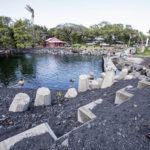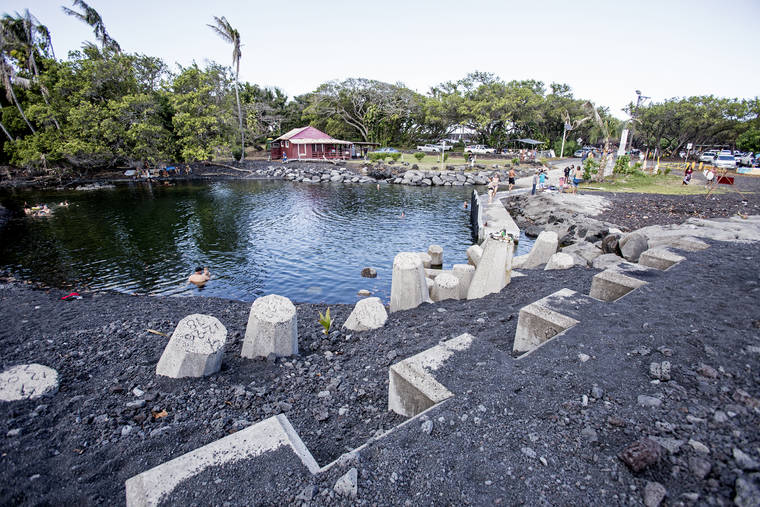Representatives from the state Department of Land and Natural Resources met last week with Puna fishermen, lawmakers and community members to further discuss possible solutions to the landlocked Pohoiki boat ramp.
The only boat ramp between Hilo and Milolii, the Pohoiki ramp closed shortly after Kilauea began erupting in May 2018 and eventually became landlocked by what is now a 200-foot-wide black sand and cobblestone beach.
While it’s technically possible to remove sand and create a channel to the existing ramp, an engineering study released in June by DLNR found that effort would be expensive and full of uncertainties associated with sand movement and coastal processes continuing in and around Pohoiki Bay.
An alternate site evaluated in the study, Malama Flats, also known as Ka‘akepa, is located just south of MacKenzie State Recreation Area and “appears to offer reasonable conditions for design of an inland excavated ramp facility, however no quantitative site information is presently available,” the engineer’s report stated.
Sea Engineering estimates it would cost approximately $37.9 million to restore the existing Pohoiki ramp, while the estimated cost for a new ramp at Malama Flats is $14.5 million.
Earlier this month, DLNR committed to visiting potential ramp sites proposed by community members during an informational meeting hosted by Puna state Rep. Joy San Buenaventura to determine whether or not the area is promising for a new ramp.
New potential boat ramp sites mentioned during that meeting were located near the existing facilities at Pohoiki.
County Councilwoman Ashley Kierkiewicz, who represents eastern Puna and attended Friday’s meeting at Pohoiki, said in an email Monday that it was well attended.
Suggestions for immediate solutions were discussed, and there was a walk-through of the area “as best we could” to scout potential long-term solutions, she said.
“I’m hopeful that we can articulate a reasonable timeline, scope of work and action plan between all parties, and work on temporary and long-term solutions in parallel,” Kierkiewicz said. “We need to get lawai‘a back in the water as soon as possible so they can get back to feeding their families and our community. A boat ramp for Puna five years from now is not going to work. This is a chance for all sides to be creative and innovative in how we get things done.”
While it “sounds to me the community is universally opposed” to the Malama Flats site evaluated in the DLNR engineering study, San Buenaventura said Monday that fishermen “really wanted their regular boat ramp back.”
“Dredging the original ramp is going to be costly and ineffective, according to the study,” she said. “The question is, can it be done at least temporarily while a port permanent solution (is found)?”
San Buenaventura said she will explore the possibility of using federal funds, such as those being used to reconstruct Highway 132, “so we can at least put the fishermen back in the water.”
San Buenaventura said DLNR is “open to all possibilities” and agreed to meet again with fishermen who will take department members out by boat.
“The original study relied on Google Maps … but Google Maps has not been updated with (the) new coastline,” she said. Local fishermen, however, are well aware of what the new coastline looks like.
There also was discussion of possible solutions that won’t require a sea wall, the construction of which San Buenaventura said would take years.
“We are moving forward and we are moving forward faster,” she said. “The state understands the importance of the ramp for the fishermen, and they’re doing their best to move rapidly at least towards a temporary solution to allow fishermen to get back into the water.”
“We’re taking into consideration what the fisherman have said,” a DLNR spokesman said Monday. “We want to see if the feasibility of their ideas can be implemented.”
The spokesman said another meeting will be scheduled with the community, although a date has not yet been set.
A resolution introduced last week by Kierkiewicz, urging the state DLNR Division of Boating and Ocean Recreation to form a working group with the county, community members and fishing community to plan and develop a boat ramp for Puna, was unanimously passed by the County Council.
“I plan to send a letter to each of the parties named in the resolution, stressing the importance of engaging the lawai‘a, especially in the planning process,” Kierkiewicz said. “Those who have knowledge of the area and who used the boat ramp have a lot to contribute in terms of site selection as they know our coastline as well as areas of historical and cultural significance.
“Since the Legislative session doesn’t start until January 2020, I will see if the state is open to a county-initiated working group. It’s so important, given Pohoiki’s location and proximity to a county park, for state, county and community to come together and implement solutions that work.”
San Buenaventura, however, said her concern is that a working group might slow the process.
“Usually, from a legislative standpoint, ‘working group’ is synonymous with delay,” she said. While such groups might work part of the time, “I don’t think delay is what the fishermen want.”
Email Stephanie Salmons at ssalmons@hawaiitribune-herald.com.











